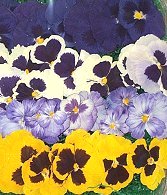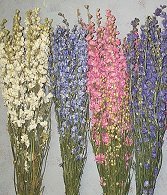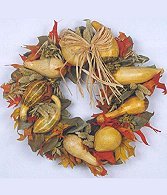With the end of the summer growing season upon us, it’s a good time to take a look at dried flowers, which could become ‘semi-permanent’ replacements for the fresh blossoms that may have been coming from the garden. And even if you don’t have a garden, dried flowers are a great way to enjoy the beauty of nature’s bounty for years at a time. Many florists carry a selection of dried flowers from which to choose, or they can readily order whatever may suit your desire. In fact, dried flowers have been experiencing something of a renaissance in popularity lately as new design styles have emerged which showcase their beautiful characteristics to full advantage. And, quite simply, some folks prefer the ‘real thing’ as opposed to silk or artificial flowers.

Freeze Dried Pansies
There are certain flowers, which may come either from the garden or from the florist, that lend themselves very well to drying, including such examples as statice, celosia, straw flower, yarrow, baby’s breath, hydrangea and larkspur. Blossoms like these can be effectively dried just by hanging them upside down in a cool, dark, and well-ventilated location for a couple of weeks (darkness helps preserve the color). Even roses can be dried in this way, although they will tend to lose their color. Select flowers that are at or nearing their peak of development; they’ll look and perform better as dried flowers than ones that have already begun to fade. Be sure to remove the foliage from the stems of flowers to be dried.
Other flowers-especially flat, so-called ‘face flowers’ like daisies, pansies, asters, cosmos and zinnias – can be dried by pressing them. Fern fronds can be dried this way as well. Simply place the flowers between several thicknesses of unglazed paper, like blotter paper, newsprint, or an old phone book. Position the flowers so that none are overlapping or touching. Then place a heavy weight, such as stacks of bricks or books, evenly distributed, on top. Flowers dried in this manner are usually ready in two to four weeks, depending on their moisture content. There are also special devices called flower presses that do an excellent job of this. The flattened, dried flowers can then be arranged into a floral picture in a framed shadow box and hung on the wall. Or they can be ‘stemmed’ by using a piece of #20 gauge florist wire. Insert the wire up through the center of the dried flower from the back side. Bend the wire into a two-inch hairpin hook at the top and gently pull the hook back down through the flower’s center until it just disappears. Then cover the wire with green or brown floral tape, and they’re ready to arrange.

Kiln Dried Larkspur
Perhaps the best way to dry flowers is by using a desiccant in which flowers are buried until they have dried. By using this method, the shapes and colors of more dimensional flowers like roses, carnations, marigolds, lilies, and dahlias can be preserved in the dried state. Old-fashioned, home mixtures, such as borax and white cornmeal (2:1) or borax and sand (2:1) may be used. But the best and fastest way is to use silica gel (actually a dry, granular material), which has the capacity to absorb large quantities of moisture and can quickly dehydrate fresh flowers. Silica gel is sold under a variety of trade names, and should be available from your local florist, garden center, or craft shop. In any case, flowers are gently and completely buried in the desiccating material, being careful to get the product in-between all the petals (it’s best to place multi-petaled flowers such as roses and carnations into the product face up). Use a container that can be tightly sealed so that the desiccant does not absorb any moisture form the air rather than from the flowers. Most flowers dried in this manner are ready in about a week. Silica gel can be re-used simply by drying again the product in a warm oven.
Flowers can also be dried in a microwave oven. In this case, bury the flowers in a desiccant as outlined above, but do not cover. Place the container into the microwave and ‘cook’ at a low-medium setting (the ‘defrost’ setting on many ovens) for about 2 ½ minutes, or, if you have a microwaveable thermometer that you can read from outside the oven, until the silica near the buried flower reaches approximately 160° F. When the container of dried flowers is removed from the microwave oven, place a lid (slightly vented) on it, and allow it to sit for about 24 hours before carefully uncovering the flowers. Since ovens, drying agents, and flowers all vary considerably, it’s best to experiment with this technique before committing ‘good’ flowers to the process.
No matter which method has been used to dry the flowers, they should then be sprayed with an aerosol sealer (again, check with your local florist) to help hold their color and minimize or prevent shattering. Avoid using anything sticky, like hairspray, which will attract dust.
Remember that dried flowers, while they do last quite a long time, aren’t really ‘permanent’. It’s usually best to replace them after 3 to 5 years. You can help extend the life of dried flowers (pun intended!) by taking good care of them. Keep dried flowers away from sunlight, which will fade them. Avoid excessive heat, humidity, and dust. Clean them regularly by blowing off the dust, using either a hair dryer on the no-heat setting, or by using canned air such as is used to blow dust off of computer keyboards and camera lenses.

Wreath of Dried Preserved Materials
Whether you choose to do-it-yourself or have your florist do the designing, dried flowers are nice to use in seasonal wreaths or door swags. Short-stemmed or stemless flower heads can be grouped and arranged very low and flat in a shallow tray or other container, using the stylish pavé technique. Taller dried materials can be massed very closely together to create a hedgerow effect. Dried flowers can be tightly arranged in concentric rings of a single variety, resulting in a classic Beidermeier style design. The shadow box idea outlined above can be a wonderful way for a bride to showcase and remember her wedding bouquet (be sure to have someone begin the drying process immediately after the wedding, while the flowers are still fresh). Your professional florist will have lots more ideas for designing with dried flowers, so stop in and talk about what kind of arrangement (or arrangements) will suit you best. Dried flowers aren’t just ‘dead’ flowers. Rather, they can have years of beautiful life left in which to decorate your own environment.


 Find Your
Find Your 
Speak Your Mind